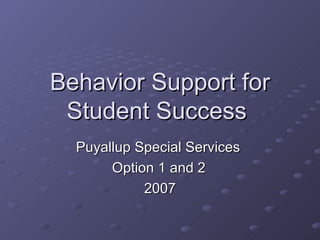BSST
- 1. Behavior Support for Student Success Puyallup Special Services Option 1 and 2 2007
- 2. “ Simply, some students will misbehave because they “won’t do it,” and others will because they try and “can’t do it.” But regardless of the emphasis, the fact remains that behavior and academic success are intimately connected and need to be intelligently addressed—together. Jeffrey Sprague, Ph.D.
- 3. Vision The BSST will lead, advocate and articulate the effective implementation of research-based best practices; consult with diverse learning systems; build professional capacity and actively support positive school climates.
- 4. Mission Statements All students, regardless of unique needs, will become socially competent and engage successfully in the school environment. All staff will actively and appropriately support students struggling with significant behaviors which hinder success in the school environment.
- 5. Why model change? Behavioral challenges are increasingly complex Current research indicates pullout model is ineffective for most students Increased accountability for Special Ed. students Lack of correlation between academic performance and challenging behaviors Increased emphasis on school- wide positive behavior supports
- 6. Behavior Support Specialist Team (BSST) GOAL #1: All students, regardless of unique needs, will become socially competent and engage successfully in the school environment.
- 7. By Demonstrating: Interpersonal and intrapersonal skills Planning and decision making skills Cultural competency Resistance to negative or unsafe peer pressure Solving problems non-violently - actively seeks peaceful resolution to conflicts
- 8. Take 4 minutes to share in pairs: An example from last year where a student demonstrated one of these skills. An example from last year where a student demonstrated the LACK of one of these skills.
- 9. Behavior Support Specialist Team (BSST) GOAL #2: All staff will actively and appropriately support students struggling with significant behaviors which hinder success in the school environment.
- 10. Team Approach Behavior Support Specialist Team (BSST) Kite focus SRC/School Team focus Autism focus
- 11. BSSTeam 2006-2007 KITE Focus: AUTISM Focus: SRC/School Focus: Freda Carda Amy Okeze Phyllis Ellermeier Caitilin Ceaough Kelly Goodsell Michelle Ballard Steve Dubay Casey Huber Shirley Patterson Gina Rice Consultant: PSS Administrator: Dr. Greg Williams Brian Berg
- 12. Service Delivery Roles of BSST…consultative vs. imbedded Specially Designed Instruction (SDI) for behavior is provided directly to students who demonstrate significant frequency, intensity and duration…(differentiated instruction)
- 13. Plan for Building Capacity Increasing knowledge base in order to have skills necessary to participate in this model Resources are BSSTeam, outside consultant, Special Services Administration and Education Specialists Support school based SRC teams
- 14. How do schools access the BSSTeam???
- 15. Referral Process School /Intervention team/SRC Team meets to discuss concerns. Team develops and implements plans of intervention to remediate behaviors. Collaborative approach to understanding function of behaviors, selection if interventions and data collection Linked to school wide implementation of positive behavioral supports Outcome of process is the selection of effective interventions that support the student’s success
- 16. Best Practice & Researched-Based Interventions Provide interventions for students with problematic behavior that interferes with learning in the school and classroom setting
- 17. Elements to PBS Outcomes -academic and behavior targets that are endorsed and emphasized by students, families, and educators Practices- interventions and strategies that are evidence based Data -information that is used to identify status, need for change, and effects of interventions Systems -supports that are needed to enable the accurate and durable implementation of the practices of PBS
- 18. More PBS . . . . Function-based and intentional approach to eliminate problem behaviors & replace them with pro-social skills. Schools implementing system-wide PBS interventions report increased engagement and increased academic performance PBS – it is what WE do . .the change in our behaviors will result in improved behavior of the student(s) in focus.
- 19. Setting up a system’s model of discipline
- 20. 1. List school wide interventions at your school? 2. Large group discussion: Successes/Challenges
- 21. Prevention Primary -Reduce new cases of problem behaviors Secondary -Reduce current cases of problem behaviors Tertiary -Reduce, complications, intensity, severity of current cases
- 22. Targeted & Intensive Individual Interventions Plan efficient school-level layers of positive interventions for individual students. “ Students benefit from implementing behavior education plans. There are higher rates of academic engagement and fewer office discipline referrals. (Hawkins & Hornes, 2003)
- 23. Individualized behavior interventions: Shifting our perspective on behavior Taking an ecological view and recognizing that students of today have unique needs Accentuate the positive ●
- 24. Key Features of BSST Model An e cological view of student behavior; Issues in programming for generalization ; Variables affecting the efficacy of social skill instruction ; The development of school-wide positive behavioral support (PBS) environments.
- 25. Include Model Step 1: I dentify the classroom environment Step 2: N ote students’ strengths and needs Step 3: C heck for potential areas of success Step 4: L ook for triggers Step 5: U se (data) to problem solve Step 6: D ecide on positive intervention Step 7: E valuate student progress
- 26. What are Best Practices in Educating Students with Emotional/Behavioral Disorders? Behavior Response Plans-building-wide, classroom, and individuals Academic Instruction –modify for all learners Social Skill Instruction Meta-cognition Instruction – “thinking about thinking” Wrap Around Services – “It takes a village . . “ Functional Behavioral Assessment, FBA Behavior Intervention Plan, BIP Aversive Therapy Plan
- 27. Your Input Questions/Concerns Your needs Discussion
- 28. Next Steps?
- 29. Building Plans Training for you next year-when and what? Wildwood’s focus and/or emphasis Classroom continuity School-based supports
- 30. BSSTeam Plans More training for all staff to be effective with all students. Repeat variations of our two district wide trainings in January and March 2007. Add fall training for all about “Motivating our students –what works.” Develop more training opportunities for all staff and Special Education IEP developers. Continue to build and expand our own knowledge to become even more supportive for school SRC teams and General Ed. Staff.
Editor's Notes
- Gina

